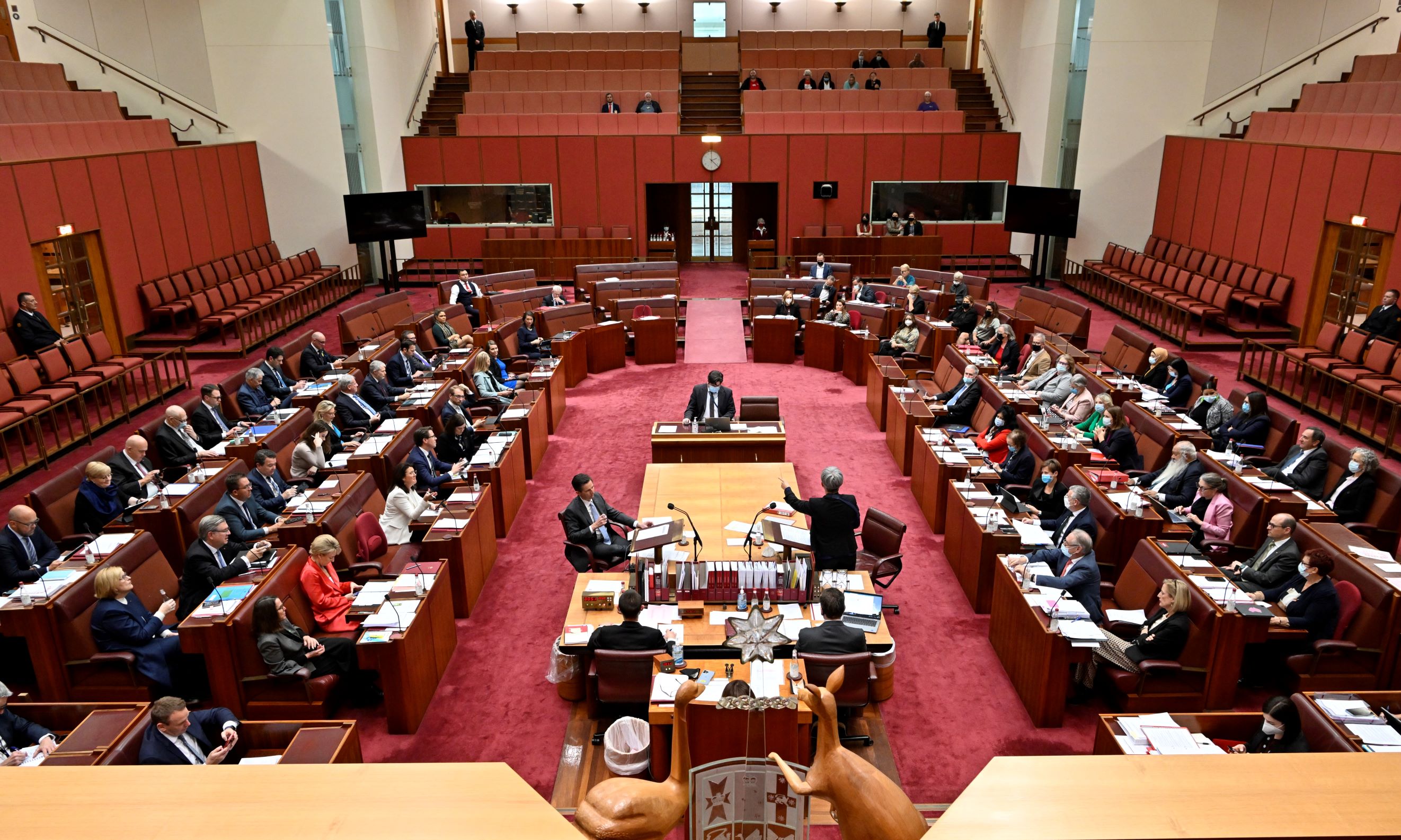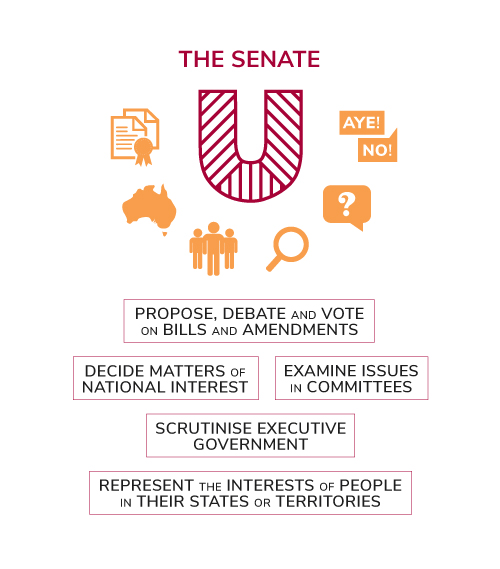Senate
This fact sheet explores the Senate, which is part of the Australian Parliament. It includes information about the role, appearance and origins of the Senate.
What will I learn?
- The Senate is one of 2 houses of the Australian Parliament.
- The Senate has an important role representing Australians and making laws.
- Parts of the Senate were inspired by the British and United States systems of government.
Curriculum alignment
Year 6 ACHASSK143
Year 7 ACHCK048
The Senate from behind the President of the Senate's chair

DPS Auspic
Description
This image is of a large room with red furnishings. The seats are arranged in a horse-shoe shape around a large central table. There are people sitting in the seats and papers on the desks.
Copyright information
Permission should be sought from DPS AUSPIC for third-party or commercial uses of this image. To contact DPS AUSPIC email: auspic@aph.gov.au or phone: 02 6277 3342.
What is the Senate?
The Senate is one of 2 houses of the Australian Parliament. The other house is the House of Representatives. The Senate is also known as the upper house. Senators are elected to the Senate by the people of Australia in federal elections.
Role
Role of the Senate.

Parliamentary Education Office (peo.gov.au)
Description
This diagram illustrates the role of the Australian Senate. The Senate: decides matters of national interest; represents the interests of people in their states or territories; proposes, debates and votes on bills and amendments; examines issues in committees; and scrutinises—closely examines—executive government.
Copyright information
This work is licensed under a Creative Commons Attribution-NonCommercial-NoDerivs 3.0 Unported License.
You are free to share – to copy, distribute and transmit the work.
Attribution – you must attribute the work in the manner specified by the author or licensor (but not in any way that suggests that they endorse you or your use of the work).
Non-commercial – you may not use this work for commercial purposes.
No derivative works – you may not alter, transform, or build upon this work.
Waiver – any of the above conditions can be waived if you get permission from the copyright holder.
Role of the Senate.

Parliamentary Education Office (peo.gov.au)
Description
This diagram illustrates the role of the Australian Senate. The Senate: decides matters of national interest; represents the interests of people in their states or territories; proposes, debates and votes on bills and amendments; examines issues in committees; and scrutinises—closely examines—executive government.
Copyright information
This work is licensed under a Creative Commons Attribution-NonCommercial-NoDerivs 3.0 Unported License.
You are free to share – to copy, distribute and transmit the work.
Attribution – you must attribute the work in the manner specified by the author or licensor (but not in any way that suggests that they endorse you or your use of the work).
Non-commercial – you may not use this work for commercial purposes.
No derivative works – you may not alter, transform, or build upon this work.
Waiver – any of the above conditions can be waived if you get permission from the copyright holder.
The Senate is made up of 76 senators. Twelve senators represent each state and 2 senators represent each territory.
In the Senate:
- Senators represent the views of Australians and discuss matters of national and international importance.
- National laws are made and changed, by debating and voting on bills – proposed laws. A bill must be agreed to in identical form by both the Senate and the House of Representatives and signed into law by the Governor-General.
- The work of the government is scrutinised – closely examined – especially in Question Time and through committees.
Appearance
The Senate sits in a large red room in Australian Parliament House. The red ochre tones used in the Senate are typical of the Australian landscape.
The seats in the Senate are arranged in rows to form a U-shape. The President of the Senate sits at the open end of the U-shape and is responsible for running meetings of the Senate. Government senators sit to the right of the President and opposition senators to the left. The Leader of the Government in the Senate and the Leader of the Opposition in the Senate sit in front of their teams at the central table. Minor parties and independents sit in the seats in the curved section of the U-shape.
The Senate has 4 viewing galleries. The one behind the President’s Chair is for the press gallery. The other galleries are open to the public, so anyone can watch meetings of the Senate.
Origins
The drafters of the Australian Constitution looked at the British—Westminster—and United States systems when developing the Australian system of government. From Britain they took the idea of 2 houses of parliament working together to make laws. From the United States, they took the name ‘Senate’ and equal representation from each state. Red was chosen for the Senate because it reflects the red of the House of Lords, the upper house of the UK Parliament.
